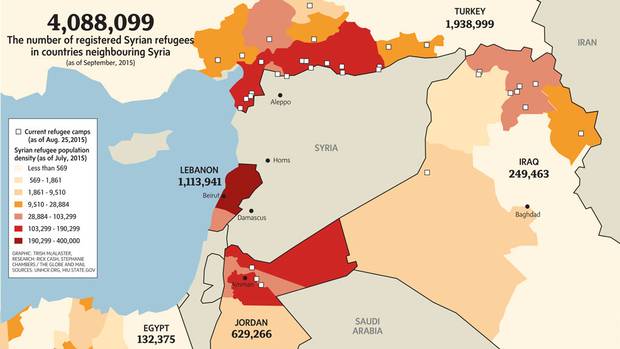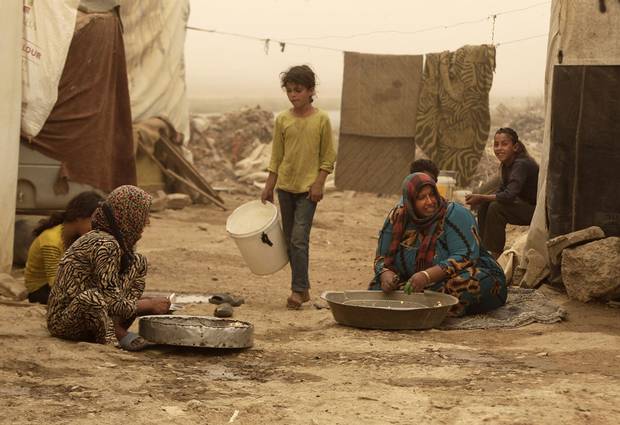As the European Union contemplates the creation of a coherent refugee policy, Lebanon, Turkey and Jordan have had no choice but to accept, four years on, that Syrian refugees who sought shelter in their countries are there to stay for the foreseeable future.
There are more than four million Syrian refugees registered with the United Nations High Commission for Refugees, and millions more displaced within the borders of the war-torn country. Policies to manage the refugee crisis vary in Lebanon, Turkey and Jordan, but the devastating long-term effects are alike in deteriorating public services, including education, health and infrastructure; rising social tensions; and bleak economic outlooks.
Only 10 per cent of Syrian refugees are attempting to make the dangerous journey to Europe, according to the UNHCR. For the rest, remaining in the Middle East means accepting a hand-to-mouth existence. Even the United Nations agencies mandated to provide relief are struggling amid severe funding gaps.

Trish McAlaster, Rick Cash and Stephanie Chambers/The Globe and Mail / Sources: UNHCR, HIU.State.Gov
Without the right to work, many, including women and children, have proliferated in the informal sector, competing with the destitute among the local population. Financial insecurity has led many refugee families to take drastic measures: Parents have reluctantly married off their teenage girls and children have had to forgo schooling in order to work.
"Destabilization will come when you have a generation of children growing up in an environment where there is no education and social support," explained Lina Khatib, an expert based at the University of London and former director of the Carnegie Middle East Center. There are currently 13 million children deprived of an education due to conflicts in the region, according to UNICEF, a substantial number of them are Syrian. "It's not that Syrian refugees are engaging in military action or joining gangs that is the problem, what we are seeing is a social catastrophe in the making."
Lebanon
With nearly 1.2 million registered refugees, Lebanon's population has surged 20 per cent since 2011. The deluge has overwhelmed infrastructure and public services, touching on every aspect of life.
Lebanon does not have refugee camps for Syrians. If they can afford it, refugees rent out private apartments. But most come from humble means and must make a home wherever they can; in tented gatherings scattered across governorates where they brave the outdoor elements, or in urban garages, slums and fields. Food assistance, amounting to just $13.50 (U.S.) a month, is barely enough to meet needs.
Meanwhile, the perpetually deadlocked Lebanese government has been unable to formulate a comprehensive policy for Syrian refugees. The government's main focus appears to be building up its state institutions in the face of a long-term refugee problem, but not addressing the needs of the vulnerable community itself.

Syrian refugees peel garlic outside their tents during a sandstorm, in a refugee camp in the town of Bar Elias, in Lebanon’s Bekaa Valley, Tuesday, Sept. 8, 2015. Many residents of the camp peel garlic for restaurants, getting 30 cents in return for every kilogram of garlic they peel. The unseasonal sandstorm hit Lebanon and Syria, reducing visibility and sending dozens to hospitals with breathing difficulties because of the fine dust.
Bilal Hussein/AP Photo
Lebanon does not legally recognize Syrians as refugees. This means that, even with UNHCR status, Syrians must pay an annual fee to renew their legal residency in the country, a sum too large for most families. As a result, a rising number of Syrians are opting to reside in the country illegally.
Part of the challenge for the government and NGOs is the fact that the majority of refugees have settled in chronically underfunded rural municipalities. "The government was already weak and incapable of meeting the needs of citizens before the crisis – the influx only made the issue more acute," Dr. Khatib said.
Recently the Lebanese labour ministry stopped giving work permits to the few Syrians able to find Lebanese sponsors. As a last resort, families have pulled their children out of school to support the family.
Turkey
Syrians are considered legal guests by the Turkish government, not refugees. Since 2011 around 1.9 million Syrian refugees have streamed across the 400-kilometre border between Turkey and Syria; fewer than 300,000 live in 22 camps across 10 provinces operated by the government and under the watchful eyes of state security. Last year, the government revised its refugee policy and strengthened the role of the Directorate General of Migration Management to better organize its refugee population.
Though billions were spent to provide food, health and education services to refugees in the camps, the majority of Syrians chose to live in urban areas without regularized support services. Large discrepancies exist between Syrians living in camps and in cities, a reality reflected in the abysmal number of Syrian children able to attend school in urban centres.
Still, Turkey has been hospitable toward refugees. Though not legally permitted, Syrians are able to find work – but jobs are scarce and underpaid. As the war in Syria persists, refugees risk being ensnared in the crossfire between the Turkish government and the Kurdish PKK militants, as well as the broader intervention against Islamic State.
"The main problem for Syrian refugees [in Turkey] is integration, legalizing their status in Turkey, and simply surviving," explains Akin Unver, assistant professor of international relations at Kadir Has University in Istanbul. "Turkey gradually became overwhelmed by the sheer number of refugees," he said.
Jordan
In Jordan, the influx of more than 629,000 refugees has overwhelmed demands on schools, housing, food, electricity and water resources and the government has suffered huge financial losses due to the loss of Syrian export routes.
Jordan inaugurated the Zaatari refugee camp for Syrians in 2012, and another, Azraq camp, in 2014, but only a small fraction of Syrians actually live there. Most dwell in urban areas in Amman, Irbid, Mafraq and Zarqa, where they suffer from extreme poverty and live in substandard living arrangements, such as garages and chicken houses. The majority live without heating during the winter.
Even for Syrian children who have access to education within the camps, only a negligible number are attending. Meanwhile, rents have soared while competition for work remains fierce in urban areas, drawing the ire of Jordanians who perceive Syrians to be unfairly benefiting from UN aid.
The influx has also strained Jordan's worn infrastructure and heightened fears of an impending water crisis.
To prevent movement out of the camps and toward cities, in July, 2014, the Jordanian government instructed UNHCR to stop issuing Asylum-Seeker Certificates to refugees to leave formal settlements. Without this essential document, Syrian refugees cannot access cash and food assistance. The tougher stand, though rarely addressed by Jordanian officials, might be a sign that Jordan has reached its limit.

The Zaatari refugee camp was the first official camp built by the Jordanian government in July 2012. The three satellite images, taken in September 2012, January 2013 and December 2013 illustrate its rapid growth. Today, Zaatari has a population of more than 80,000 people, making it one of the largest population centres in the country.
DigitalGlobe via Getty Images
Iraq, Egypt and North Africa
The civil war in Syria has forced hundreds of thousands of people to seek shelter in Iraq, Egypt and in parts of North Africa. As the war has dragged on, the direction of forced migration for many Iraqi refugees has reversed, reports Refugees International. Tens of thousands of Iraqis who sought refuge in Syria between 2003 and 2011 have returned home, joining about a million Iraqis who were already internally displaced. About 38 per cent of the Syrian refugees live in camps in Iraq, the U.S. State Department says. No refugees live in camps in Egypt. Egyptian billionaire Naguib Sawiris has proposed buying an island from the Greek or Italian governments so he can offer Syrian refugees sanctuary and jobs there.
By the numbers
3800 m3
Or 3,800,000 litres of safe water delivered daily to the Zaatari refugee camp in Jordan. Water is delivered by truck from two internal boreholes operated by UNICEF and a number of external boreholes owned and operated by private individuals.
50 cents
Daily value of food vouchers distributed to 1.3 million vulnerable Syrian refugees in the region by the UN World Food Program. The WFP reports having to cut its level of assistance due to funding shortages, reducing the number of refugees it supports from 2.1 million at the beginning of 2015. Food vouchers are worth about $13.50 (U.S.) per person, per month in Lebanon and $14 in Jordan.
4.27 million
UNHCR's estimated number of Syrian refugees by the end of 2015. Currently, UNHCR estimates there are approximately 7.6 million people displaced within Syria.
5.6 million
Number of children that UNICEF reports are living in dire situations inside Syria and face poverty, displacement and peril from battle. UNICEF reports that two million Syrian children live as refugees in Lebanon, Jordan, Iraq, Turkey, Egypt and other countries in North Africa.